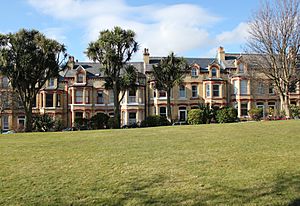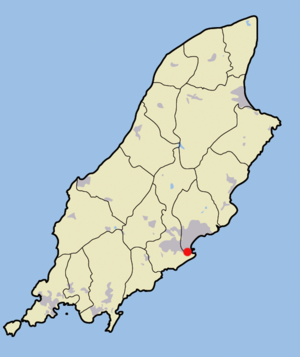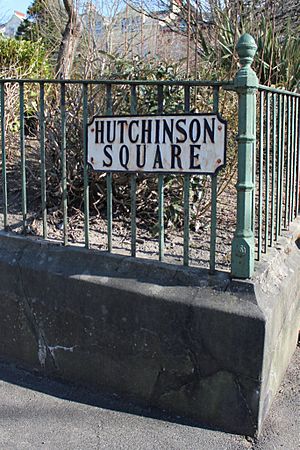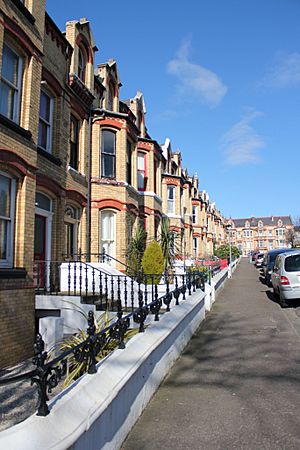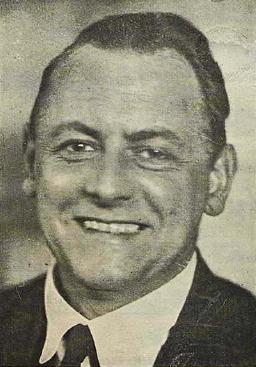Hutchinson Internment Camp facts for kids
Hutchinson Internment Camp was a special place during World War II. It was a camp where people were held, called an internment camp. It was located in Douglas on the Isle of Man. This camp became famous as "the artists' camp." This was because many talented artists and thinkers lived there and created amazing things.
Contents
Where Was Hutchinson Camp?
The camp was made up of 39 houses. These houses were built around Hutchinson Square in Douglas. Because many people lived in a small number of houses, some internees had to share beds. One house, called Arrandale, was used as the camp's sick bay.
Major H. O. Daniel was the camp's leader for a while. He was well-liked and helped a lot with the creative activities.
A Look Back: Camp History
Hutchinson Camp opened in July 1940. Before it opened, the people living in the houses had to move out. Two barbed wire fences were put up around the area.
At first, there were 415 internees, which are people held in the camp. By the end of July, this number grew to 1,205. Most of these people were from Germany and Austria.
From September 1940, the number of internees started to drop. People who were not seen as a threat to Britain were released. Many people in Hutchinson Camp were Jewish or against the Nazi party.
The camp closed in March 1944. The remaining 228 internees moved to Peveril Camp. Hutchinson Camp was then prepared to be used for prisoners of war.
Daily Life at Hutchinson Camp
Many photos from around 1940-1941 show what life was like. These pictures were mostly taken by Major H. O. Daniel. They give us a good idea of the camp's facilities and the art created there. You can see these photos in the Tate Archive.
Camp Jobs and Roles
The houses in the camp worked like separate groups. Internees took on different jobs. These jobs included leaders, kitchen staff, cleaners, and cooks.
The British guards set up these roles. But the internees changed the title "Camp Captain" to "Camp Leader" or "Camp Father." This showed they didn't want a military feel.
Sometimes, professional chefs in the camp became the cooks. Others would help by preparing fresh local food. This is how internees learned to enjoy local Manx kippers. Some even called them "Yom Kippur" as a joke!
Working Inside and Outside the Camp
After a while, internees could apply to work outside the camp. Many worked on local farms. They also continued their old jobs inside the camp.
There were tailors and barbers. A baker from Vienna made cakes for an "artists' cafe." This cafe was set up in a laundry room. Artists also sold their paintings and portraits to others in the camp.
Sports and Fun
Like in other camps, internees often played sports. Hutchinson Camp had a football team. They played in a league against other camps. Their games were usually at Onchan Camp, which had a football field.
Internees were also allowed to go for walks outside the camp. Guards went with them. They could even go to Douglas Bay to swim. One Italian internee, who competed in the 1936 Summer Olympics, wore his Olympic shirt as a protest.
Another sport played was boules on the camp's green lawn. They used brass balls from bed frames because they didn't have real boules balls.
How People Felt
On the outside, internees often seemed to be enjoying themselves. But many felt sad or frustrated deep down. Helmuth Weissenborn later said that "internment was a continuous torment."
They felt helpless about how long they would be held. They also felt angry about being held unfairly. This was especially true for those who had suffered in Nazi concentration camps before coming to Britain.
Even famous artist Kurt Schwitters seemed happy to many. But in his own room, he would tell his son how truly sad he felt.
Creative Activities Flourish
The Camp University
The camp had many smart and creative people. They were eager to teach and learn. Within weeks, the internees set up a camp 'university.' They had already done this in other camps.
The university was in a building on the north side of the square. It was called the 'lecture house.' Lectures also happened on the lawn when the weather was good. Smaller classes were held in people's rooms.
Scientists, mathematicians, lawyers, writers, and artists all taught classes. Musicians also gave lessons to students in their rooms.
'The Camp' Newspaper
Hutchinson Camp even had its own newspaper, called The Camp. It was written in English by and for the internees. It had reviews, stories, and news from inside and outside the camp. The first issue came out on September 21, 1940.
Even with all the artists, the paper had no pictures. This was different from the Onchan Pioneer newspaper from another camp.
Other writings by internees were also shared. Kurt Schwitters' short story, "The Flat and the Round Painter," was translated and shared in the camp.
Amazing Art
Hutchinson Camp was famous for its lively art scene. Many important artists were there. The art created included sculptures, paintings, graphic art, Expressionism, Dadaism, naive art, and engraving.
Klaus Hinrichsen, who led the camp's cultural group, said the camp had almost every art style that was banned in Nazi Germany.
An art show was held in the camp just one month after it opened. It was so popular that a second show happened in November 1940. Artists like Kurt Schwitters showed their work. They often sold pieces for a small fee to other internees.
Artists like Fred Uhlman, who taught himself to paint, created almost one piece of art every day! Kurt Schwitters, a very important artist, made over 200 works in 16 months. He drew more portraits there than at any other time in his life.
All this art meant they ran out of supplies quickly. Artists had to be very clever. They mixed brick dust with sardine oil to make paint. They dug up clay during walks for sculptures. They even ripped up lino floors to make linocut prints. They pressed these through a clothes mangle!
They also used brown paper from packages, toilet paper, and wallpaper from the walls. The engraver, Hellmuth Weissenborn, started a trend. He engraved pictures into the dark blue paint on the windows. This paint was used to block light during air raids.
Later, things got better for artists. Major H.O. Daniel understood their needs. He got art supplies for them. He also gave some artists, like Kurt Schwitters, studio space. In these studios, artists could teach students. The students learned a lot from working closely with these great artists.
Music in the Camp
Major Daniel also helped music to thrive. He got instruments for the internees. A camp orchestra quickly formed, led by Professor Kästner. They played music by famous composers like Bach, Mozart, Schubert, Beethoven, and Brahms.
One famous musician was the concert pianist, Marjan Rawicz. He often gave performances. Once, he tried out 11 pianos in the camp to find the best one. When he tried one, it broke apart! Other internees quickly used the pieces. Artists took the wood for painting. The metal strings were used for electrical wiring. A dentist even used the ivory keys for false teeth!
Theatre and Performances
Theatre was also popular in the camp. Plays happened wherever space was found. There was a show of John Steinbeck's Of Mice and Men in a crowded bedroom. There were also funny skits, like a version of Shakespeare's Romeo and Juliet about "Romeo and Julian."
Kurt Schwitters also performed his Ursonate. This was a unique sound poem that could last up to forty minutes. It was so popular that some internees used parts of it as greetings! Schwitters also did other unusual performances. He would sometimes sleep under his bed or bark like a dog.
Hutchinson as a POW Camp
After Hutchinson Camp closed for internees in March 1944, it became a camp for prisoners of war. Getting it ready took a long time. New furniture had to be made, and the old furniture was moved out. The barbed wire fences were made stronger, watchtowers were built, and more guards were added.
On November 22, 1944, about 5,000 German prisoners of war arrived on the island. Many of them went to Hutchinson Camp. This was the first group for the camps on the island, which were now called 171 POW Camp.
The prisoners left the camp by August 4, 1945. By November 24, the original owners and renters of the houses in Hutchinson Camp were told they could move back in.
Famous People Held Here
- Bruno Ahrends, an architect from Berlin
- Gerhard Bersu, an archaeologist
- Carl Ludwig Franck, an architect from Berlin
- Hans G. Furth, a psychology professor
- Paul Hamann, a sculptor from Hamburg
- Klaus Hinrichsen, an artist from Lübeck
- Erich Kahn, a graphic artist
- Arthur Koestler, a writer from Budapest
- Walter Landauer, a pianist from Vienna
- Rudolf Olden, a journalist
- Marjan Rawicz, a pianist from Poland
- Kurt Schwitters, a famous artist (dadaist)
- Fred Uhlman, a writer and painter
- Egon Wellesz, a composer and music expert
- Günther Zuntz, a scholar of ancient history
See also
- Category: People interned in the Isle of Man during World War II
|


